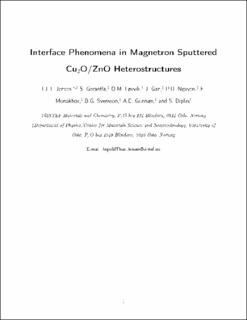| dc.contributor.author | Jensen, Ingvild Julie Thue | |
| dc.contributor.author | Gorantla, Sandeep Madhukar | |
| dc.contributor.author | Løvvik, Ole Martin | |
| dc.contributor.author | Gan, Jiantuo | |
| dc.contributor.author | Nguyen, Phuong Dan | |
| dc.contributor.author | Monakhov, Edouard | |
| dc.contributor.author | Svensson, Bengt Gunnar | |
| dc.contributor.author | Gunnæs, Anette Eleonora | |
| dc.contributor.author | Diplas, Spyridon | |
| dc.date.accessioned | 2020-12-22T12:48:50Z | |
| dc.date.available | 2020-12-22T12:48:50Z | |
| dc.date.created | 2017-12-18T13:46:09Z | |
| dc.date.issued | 2017 | |
| dc.identifier.issn | 0953-8984 | |
| dc.identifier.uri | https://hdl.handle.net/11250/2720794 | |
| dc.description.abstract | The interface between ZnO and Cu2O has been predicted to be a good candidate for use in thin film solar cells. However, the high predicted conversion efficiency has yet to be fully realized experimentally. To explore the underlying causes of this we investigate the interface between ZnO and Cu2O in magnetron sputtered samples. Two different sample geometries were made: In the first set thin layers of ZnO were deposited on Cu2O (type A), while in the second set the order was reversed (type B). Using x-ray photoelectron spectroscopy (XPS), an intermediate CuO layer was identified regardless of the order in which the Cu2O and ZnO layers were deposited. The presence of a CuO layer was supported by transmission electron microscopy (TEM) results. Changes in the electron hole screening conditions were observed in CuO near the interface with ZnO, manifested as changes in the relative peak-to-satellite ratio and the degree of asymmetric broadness in the Cu 2p peak. The suppression of the Cu 2p satellite characteristic of CuO may cause the CuO presence to be overlooked and cause errors in determinations of valence band offsets (VBOs). For the type A samples, we compare four different approaches to XPS-based determination of VBO and find that the most reliable results are obtained when the thin CuO layer and the altered screening conditions at the interface were taken into account. The VBOs were found to range between 2.5 eV and 2.8 eV. For the B type samples a reduction of the Cu 2p-LMM Auger parameter was found as compared to bulk Cu2O, indicative of quantum confinement in the Cu2O overlayer. | en_US |
| dc.language.iso | eng | en_US |
| dc.publisher | IOP Science | en_US |
| dc.title | Interface phenomena in magnetron sputtered Cu2O/ZnO heterostructures | en_US |
| dc.type | Peer reviewed | en_US |
| dc.type | Journal article | en_US |
| dc.description.version | acceptedVersion | en_US |
| dc.rights.holder | This is the Accepted Manuscript version of an article accepted for publication in Journal of Physics: Condensed Matter. IOP Publishing Ltd is not responsible for any errors or omissions in this version of the manuscript or any version derived from it. The Version of Record is available online at https://iopscience.iop.org/article/10.1088/1361-648X/aa8799 | en_US |
| dc.source.pagenumber | 27 | en_US |
| dc.source.volume | 29 | en_US |
| dc.source.journal | Journal of Physics: Condensed Matter | en_US |
| dc.source.issue | 43 | en_US |
| dc.identifier.doi | 10.1088/1361-648X/aa8799 | |
| dc.identifier.cristin | 1529012 | |
| dc.relation.project | Norges forskningsråd: 197405 | en_US |
| cristin.unitcode | 7401,80,6,2 | |
| cristin.unitname | Materialfysikk. Oslo | |
| cristin.ispublished | true | |
| cristin.fulltext | postprint | |
| cristin.qualitycode | 1 | |
